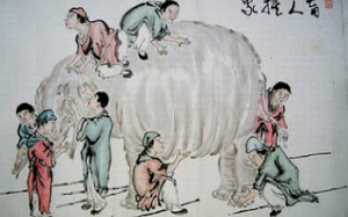 Let’s admit it, our middle management needs a radical makeover, a new fitness regime to make us far more innovation fit.
Let’s admit it, our middle management needs a radical makeover, a new fitness regime to make us far more innovation fit.Continue reading “Redesigning the organizations middle for a new innovation shape.”
Building Your Innovation Intelligence
Bringing my thinking and solutions to your problems
 Let’s admit it, our middle management needs a radical makeover, a new fitness regime to make us far more innovation fit.
Let’s admit it, our middle management needs a radical makeover, a new fitness regime to make us far more innovation fit. I often think of the parable of “The Elephant and the Blind Men” when I get into discussions about measuring innovation.
I often think of the parable of “The Elephant and the Blind Men” when I get into discussions about measuring innovation.
What are truths, what are the fallacies? The parable implies that one’s often subjective experience can be true on your need, but not necessarily the other person’s view of their understanding of value.
You get, as the end result, a failure to account for other ‘beliefs’ or capture the real value and miss providing broader motivations to encourage the innovation elephant along.
Establishing the right metrics that motivate and yield the result you are looking for is sometimes a tough challenge. You should always start with the bigger picture, organizational needs and then design the metrics and cascade these throughout the organization.
Continue reading “Measuring and motivating the innovation elephant”

I describe innovation as very much like a tropical rainforest, needing constant fresh attention, similar in its management,
There is my need to cut down certain trees, clear away a lot of the floor covering to allow the sunlight in and permit those ‘selected innovation trees’ to be allowed to grow stronger.
We all have those times where we need to choose, to pursue clearer pathways we believe are better for us. To be more selective in what we do, to be more focused and hopefully achieve a better, lasting result that hopefully offers a more satisfying set of outcomes, to both clients and to ourselves.
Within this comparison I am presently making of innovation being like a forest, I really began to see so much more of a connection in what is happening around innovation that it can be compared to understanding a tropical rainforest. There are many comparisons, let me outline some of these here.
The ecosystem within the rainforest is also needed for innovation to work effectively Continue reading “Innovation is like a tropical rainforest constantly needing attention”
Julian Birkinshaw, the London Business School Professor for Strategy and Entrepreneurship wrote in his book “Reinvention Management” about the failure of management. He is a strong advocate of reinventing and broadening out the awareness and need for a more disciplined and up to date practice of management
Working through a kind of contingency theory of management
Julian points out different situations demand different kinds of management. To be effective, a manager needs to adapt to the demands of the situation. Managerial behaviour is mapped on four dimensions: bureaucracy-to-emergence, hierarchy-to-collective wisdom, alignment-to-obliquity, and extrinsic-to-intrinsic motivation.
The principles of emergence, collective wisdom, obliquity and intrinsic are newer ways of thinking about management. I must say I like these as I do his framework as a really good way to think about the approach we need to explore that fits with the strategy and the way we want to develop a business and its environment.
Innovation needs to exploit all the ‘opposing’ principles across the four dimensions
Continue reading “Framing innovation around four management dimensions”